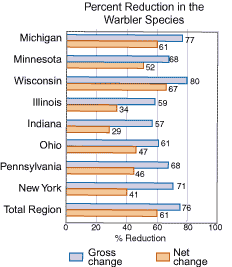|
Effects of Climate Change on Bird Distribution and Migration Patterns The Great Lakes region supports more bird species than anywhere else in the conterminous US except for northern New England. The region is the only place in the world where the endangered Kirtland´s Warbler breeds. This species nests in young (5-23 years old) jack pine stands with specific vegetation characteristics found mainly in areas of northern lower Michigan. The Great Lakes region is important for many migrating birds as well. Hawk Ridge, located just outside Duluth, Minnesota, and areas along the Detroit River are corridors for the Broad-Winged Hawk migration. More than 40 globally important sites have been identified in the Great Lakes region. The Upper Mississippi/Trempeleau National Wildlife Refuges, located along the Mississippi River between Minnesota and Wisconsin and continuing farther south into Illinois and Iowa, host more than 100,000 Canvasbacks (>20% of the world´s population) and more than 200,000 ducks of other species during their annual southbound fall migration. Bald Eagles also use this refuge, with more than 600 being found there in the winter. Climate change impac ts may include fewer duck-hunting opportunities, as well as Sharp-tailed Grouse or Gray Partridge. On the other hand, there may be more opportunities to hunt Ring-necked Pheasants and Northern Bobwhite. Models project losses of neotropical migratory bird species in Michigan (32%), Minnesota (20%) and Wisconsin (32%). Particularly hard hit would be the wood warblers with large numbers of species projected to be extirpated from Michigan (61% lost), Minnesota (52% lost) and Wisconsin (67% lost). Bird Migration and Distribution Assessment report available in PDF. |
*Gross change represents the overall loss currently found in the area *Net change represents the loss of species currently found in the area offset by the species moving into the area from outside of the region. |
